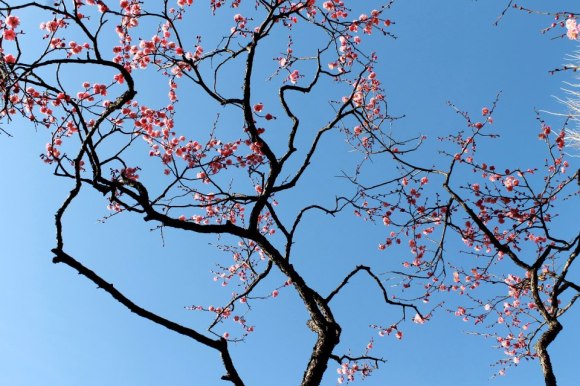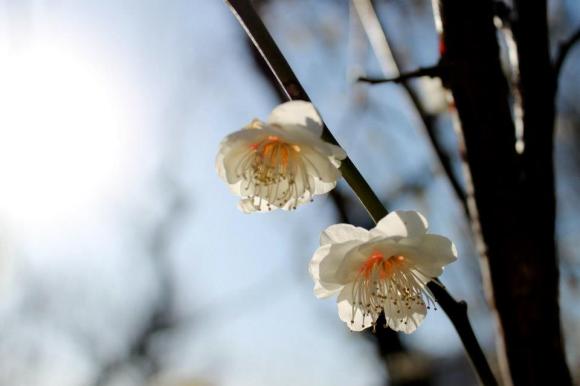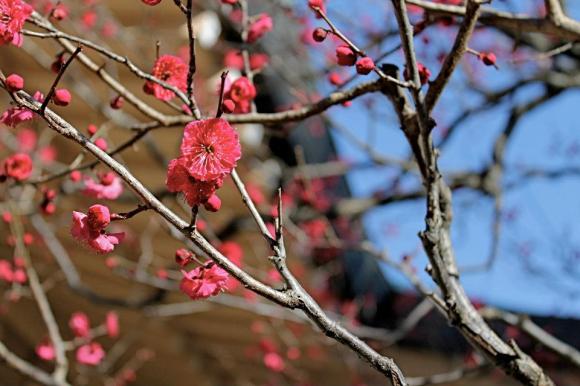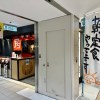
It’s cherry blossom time in Tokyo, which means that the plum blossom season is just coming to a close, and one of Tokyo’s most popular spots to see plum blossom, Umeno Park in Ome, has finished the season with a sad announcement: it is chopping down all 1,266 of its famous plum trees to prevent the spread of a disease called plum pox.
Plum blossom, or ume in Japanese, blooms just at the end of winter and come in shades of red, pink and white. Ume may not be quite as popular as the cherry blossom, since it’s usually too cold to hold parties under their blossom-laden branches, but they are beloved as harbingers of spring.
According to Ome’s agriculture and forestry division, the plum pox virus was first noticed in the city in 2009 and was spread by aphids and through grafting infected trees. Although it poses no danger to humans or animals, the virus causes discoloration of leaves and fruit and causes the fruit to fall from the tree before maturity. It can also spread to other stone fruit trees. There is no treatment available, so the only way to prevent the spread of the virus is to cut down infected plants.
Between 2009 and 2012, the city felled about 2,600 trees, but despite their efforts, the disease was found in 2010 to have spread to over a hundred trees in Umeno Park. Infected trees were cut down and removed, but the disease has continued to spread.
Last year, Japan’s Ministry of Agriculture, Forestry and Fisheries decreed that not only infected trees but those surrounding them should be felled, necessitating the destruction of some 500 trees in the park. Considering how many trees would have to be destroyed anyway, the city decided to fell all the remaining trees to be sure of eradicating the virus.
Ome has been called Japan’s number 1 city for plum blossoms, so the announcement was grave news for tourists and locals alike. The head of a local tourism cooperative was quoted as saying, “These trees are the symbol of our city. There aren’t words to express how sad this is, but we will move forward one step at a time to ensure they are resurrected.”
The city plans to replant the park once the area has been free of plum pox for three years.
Source: Yahoo! Japan News
Images: RocketNews24



 KitKat releases new Japanese plum flavor to celebrate Japan’s most beautiful winter flowers
KitKat releases new Japanese plum flavor to celebrate Japan’s most beautiful winter flowers Bug hunt! Some areas offering rewards for alien beetles threatening Japan’s cherry blossoms
Bug hunt! Some areas offering rewards for alien beetles threatening Japan’s cherry blossoms Early-blooming sakura cherry blossoms create pink-tinged wonderlands in Japan
Early-blooming sakura cherry blossoms create pink-tinged wonderlands in Japan Pizza Hut Japan’s pickled plum pizza is mercilessly aware of what it is【Taste test】
Pizza Hut Japan’s pickled plum pizza is mercilessly aware of what it is【Taste test】 These stunningly beautiful seasonal pink flowers from Japan are NOT cherry blossoms【Photos】
These stunningly beautiful seasonal pink flowers from Japan are NOT cherry blossoms【Photos】 How to order snacks on a Shinkansen bullet train in Japan
How to order snacks on a Shinkansen bullet train in Japan New Nintendo Lego kit is a beautiful piece of moving pixel art of Mario and Yoshi【Photos】
New Nintendo Lego kit is a beautiful piece of moving pixel art of Mario and Yoshi【Photos】 Demon Slayer: Kimetsu no Yaiba gets new roller coaster attractions and food at Universal Studios Japan
Demon Slayer: Kimetsu no Yaiba gets new roller coaster attractions and food at Universal Studios Japan New samurai glasses are Japan’s latest weird must-have souvenir
New samurai glasses are Japan’s latest weird must-have souvenir Finally! Nintendo Japan expands Switch 8-bit controller sales to everybody, Online member or not
Finally! Nintendo Japan expands Switch 8-bit controller sales to everybody, Online member or not Apartment in Japan explodes following bizarre series of events【Video】
Apartment in Japan explodes following bizarre series of events【Video】 McDonald’s adds a new Cheese Bacon Potato Pie to its menu in Japan for a limited time
McDonald’s adds a new Cheese Bacon Potato Pie to its menu in Japan for a limited time Nintendo history you can feel – Super NES, N64, and GameCube controllers become capsule toys
Nintendo history you can feel – Super NES, N64, and GameCube controllers become capsule toys Tokyo Station’s perfect breakfast spot might just be this izakaya Japanese-style pub
Tokyo Station’s perfect breakfast spot might just be this izakaya Japanese-style pub High-fashion Totoro cuddle purse is like an elegant stroll in the forest【Photos】
High-fashion Totoro cuddle purse is like an elegant stroll in the forest【Photos】 Hello, cosmetics! Clinique teams up with Hello Kitty this summer for first-time collaboration
Hello, cosmetics! Clinique teams up with Hello Kitty this summer for first-time collaboration “The most Delicious Cup Noodle in history” – Japan’s French Cup Noodle wins our heart【Taste test】
“The most Delicious Cup Noodle in history” – Japan’s French Cup Noodle wins our heart【Taste test】 Starbucks releases a cute Frappuccino and Unicorn Cake…but not in Japan
Starbucks releases a cute Frappuccino and Unicorn Cake…but not in Japan Kyoto Tower mascot termination reveals dark side behind cute Japanese characters
Kyoto Tower mascot termination reveals dark side behind cute Japanese characters McDonald’s Japan’s Soft Twist Tower: A phantom ice cream only sold at select branches
McDonald’s Japan’s Soft Twist Tower: A phantom ice cream only sold at select branches Yabai Ramen: What makes this Japanese ramen so dangerous?
Yabai Ramen: What makes this Japanese ramen so dangerous? Japanese government wants to build luxury resorts in all national parks for foreign tourists
Japanese government wants to build luxury resorts in all national parks for foreign tourists To combat declining birth rate, Japan to begin offering “Breeding Visas” to foreigners
To combat declining birth rate, Japan to begin offering “Breeding Visas” to foreigners 10 things you should buy at 7-Eleven in Japan
10 things you should buy at 7-Eleven in Japan Studio Ghibli releases anime heroine cosplay dresses that are super comfy to wear
Studio Ghibli releases anime heroine cosplay dresses that are super comfy to wear Woman charged for driving suitcase without a license in Osaka
Woman charged for driving suitcase without a license in Osaka Studio Ghibli unveils My Neighbour Totoro miniature house model
Studio Ghibli unveils My Neighbour Totoro miniature house model Kyoto experiencing problems with foreign tourists not paying for bus fares, but not on purpose
Kyoto experiencing problems with foreign tourists not paying for bus fares, but not on purpose Fighting mild hunger with a Japanese soda that turns into jelly in the stomach【Taste test】
Fighting mild hunger with a Japanese soda that turns into jelly in the stomach【Taste test】 Studio Ghibli’s Howl’s Moving Castle tapestry unveiled in Japan for first time
Studio Ghibli’s Howl’s Moving Castle tapestry unveiled in Japan for first time McDonald’s new Happy Meals offer up cute and practical Sanrio lifestyle goods
McDonald’s new Happy Meals offer up cute and practical Sanrio lifestyle goods Sales of Japan’s most convenient train ticket/shopping payment cards suspended indefinitely
Sales of Japan’s most convenient train ticket/shopping payment cards suspended indefinitely Sold-out Studio Ghibli desktop humidifiers are back so Totoro can help you through the dry season
Sold-out Studio Ghibli desktop humidifiers are back so Totoro can help you through the dry season Japanese government to make first change to romanization spelling rules since the 1950s
Japanese government to make first change to romanization spelling rules since the 1950s Foreigner’s request for help in Tokyo makes us sad for the state of society
Foreigner’s request for help in Tokyo makes us sad for the state of society Ghibli founders Toshio Suzuki and Hayao Miyazaki contribute to Japanese whisky Totoro label design
Ghibli founders Toshio Suzuki and Hayao Miyazaki contribute to Japanese whisky Totoro label design Doraemon found buried at sea as scene from 1993 anime becomes real life【Photos】
Doraemon found buried at sea as scene from 1993 anime becomes real life【Photos】 Tokyo’s most famous Starbucks is closed
Tokyo’s most famous Starbucks is closed Princesses, fruits, and blacksmiths: Study reveals the 30 most unusual family names in Japan
Princesses, fruits, and blacksmiths: Study reveals the 30 most unusual family names in Japan Sakura in Japan 2019: The best spots for hanami cherry blossom viewing
Sakura in Japan 2019: The best spots for hanami cherry blossom viewing Most Japanese theft ever? Chainsaws taken to flowering cherry blossoms in Osaka
Most Japanese theft ever? Chainsaws taken to flowering cherry blossoms in Osaka Coca-Cola Japan unveils special New Year’s kimono bottle for 2019 with hidden boar on the packaging
Coca-Cola Japan unveils special New Year’s kimono bottle for 2019 with hidden boar on the packaging Sakura 2017: Japan Meteorological Corporation releases first national cherry blossom forecast
Sakura 2017: Japan Meteorological Corporation releases first national cherry blossom forecast Now’s your once-in-12-years chance to order this special $850 pot of pickled plums!
Now’s your once-in-12-years chance to order this special $850 pot of pickled plums! Coca-Cola adds new limited-edition design to their seasonal bottle range available only in Japan
Coca-Cola adds new limited-edition design to their seasonal bottle range available only in Japan Sakura season officially begins in Tokyo as cherry blossoms bloom at Yasukuni Shrine
Sakura season officially begins in Tokyo as cherry blossoms bloom at Yasukuni Shrine Japanese students despair over the many, MANY ways you can describe a dead flower
Japanese students despair over the many, MANY ways you can describe a dead flower Solo sakura: Four reasons to have a one-person cherry blossom-viewing party
Solo sakura: Four reasons to have a one-person cherry blossom-viewing party Sakura season 2018 officially declared in Tokyo as first cherry blossoms begin to bloom
Sakura season 2018 officially declared in Tokyo as first cherry blossoms begin to bloom Japan’s weeping plum trees are so beautiful they’ll bring tears to your eyes【Photos】
Japan’s weeping plum trees are so beautiful they’ll bring tears to your eyes【Photos】 McDonald’s Japan celebrates cherry blossom season with new cherry frappe and mocha drinks
McDonald’s Japan celebrates cherry blossom season with new cherry frappe and mocha drinks Potted mini sakura trees are perfect for everyone who missed cherry blossom season this year
Potted mini sakura trees are perfect for everyone who missed cherry blossom season this year Arashiyama bamboo forest in Kyoto “crying” as tourists vandalise trees
Arashiyama bamboo forest in Kyoto “crying” as tourists vandalise trees Legoland Japan celebrates first anniversary with world’s largest LEGO cherry blossom tree【Video】
Legoland Japan celebrates first anniversary with world’s largest LEGO cherry blossom tree【Video】 The most popular places in Japan for viewing sakura in 2024, according to local travel agency
The most popular places in Japan for viewing sakura in 2024, according to local travel agency Midwinter “cherry blossoms” are making one of Japan’s best castles even more stunning【Photos】
Midwinter “cherry blossoms” are making one of Japan’s best castles even more stunning【Photos】
Leave a Reply